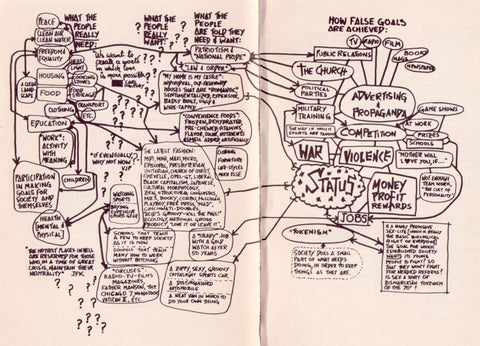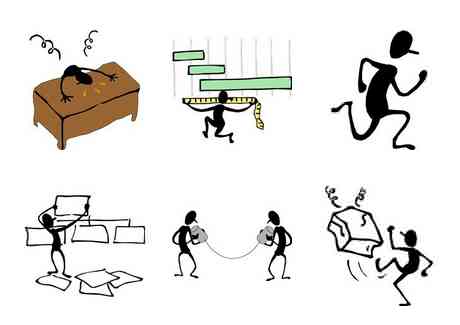





Power / Knowledge
Please allow 3 working days to process before shipping
Garment Dyed - Cobalt Long Sleeve
Made in USA - 100% USA Cotton


Victor Papanek
Victor Joseph Papanek was a designer and educator who became a strong advocate of the socially and ecologically responsible design of products, tools, and community infrastructures. He disapproved of manufactured products that were unsafe, showy, maladapted, or essentially useless. His products, writings, and lectures were collectively considered an example and inspired many designers. Papanek was a philosopher of design and as such he was an untiring, eloquent promoter of design aims and approaches that would be sensitive to social and ecological considerations.

"Design has become the most powerful tool with which people shape their tools and environments and, by extension, society and themself." -Papanek

The Tunnel Effect
Papanek used cybernetic tactics to think through everyday problems. He observed that many people push for change in the right places, but give up before built-in delay trends can take effect. Taking a step back, Papanek saw that this effort was misplaced–slowing down undesirable trends is primarily a delaying tactic to prevent lose-lose games from reaching their conclusion. Instead, the eventual strategy must be to find a way for everyone to win. The problem of bringing about change is essentially that of getting over a mountain. The solution in this case is to use the tunnel method. Papanek wrote that we can pass laws which force everyone to go over (linear thinking). Or we can use cybernetic thinking. With positive synergy–in which people work together to amplify their efforts–we can vault over the mountain. But the best way is to cut a tunnel through the mountain–to find a social, technological, or scientific innovation that in one swoop blows away old attitudes and resistance. Then no one has to go over the mountain, a win-win solution.

Foucault
Michel Foucault was a French philosopher, historian of ideas, social theorist, philologist and literary critic. His theories addressed the relationship between power and knowledge, and how they are used as a form of social control through societal institutions. Though often cited as a post-structuralist and postmodernist, Foucault rejected these labels, preferring to present his thought as a critical history of modernity. His thought has been highly influential both for academic and for activist groups, especially those working within contemporary sociology, cultural studies, and critical theory.

Foucault has served as theoretical inspiration across a multitude of disciplines, so much so that the term “Foucauldian” is often applied to analyses that utilize his theoretical approach. Outside of academia, Foucault’s work is of interest to anyone looking to better understand and appreciate the subtle ways that power works in social life, particularly with regard to how seemingly mundane practices and ideas structure our personal experiences and senses of self. History for him was a store house of good ideas. He wanted to raid it rather than keep it pristine and untouched. We should use Foucault as an inspiration to look at dominant ideas and institutions of our times and to question them by looking at their histories and evolutions.

For Foucault, power and knowledge are not seen as independent entities but are inextricably related—knowledge is always an exercise of power and power always a function of knowledge. Perhaps his most famous example of a practice of power/knowledge is that of the confession, as outlined in History of Sexuality. Once solely a practice of the Christian Church, Foucault argues that it became diffused into secular culture (and especially psychology) in the eighteenth and nineteenth centuries. Through the confession (a form of power) people were incited to “tell the truth” (produce knowledge) about their sexual desires, emotions, and dispositions. Through these confessions, the idea of a sexual identity at the core of the self came into existence (again, a form of knowledge), an identity that had to be monitored, cultivated, and often controlled (again, back to power). It is important to note that Foucault understood power/knowledge as productive as well as constraining. Power/knowledge not only limits what we can do, but also opens up new ways of acting and thinking about ourselves.

Foucault argues that discipline is a mechanism of power that regulates the thought and behavior of social actors through subtle means. In contrast to the brute, sovereign force exercised by monarchs or lords, discipline works by organizing space (e.g. the way a prison or classroom is built), time (e.g. the set times you are expected to be at work each day), and everyday activities. Surveillance is also an integral part of disciplinary practices. In Discipline and Punish, Foucault argues that modern society is a “disciplinary society,” meaning that power in our time is largely exercised through disciplinary means in a variety of institutions (prisons, schools, hospitals, militaries, etc.).

Régis Debray, Unearthing Potentials
‘Since 1789, ideas alone have constituted the strength and salvation of the proletariat. It owes to them its every victory’, wrote Blanqui (one of those who passed the ideas of 1789 on to the Paris Commune). Abstract concepts were the abc of a militant’s apprenticeship. The notions of proletariat and bourgeoisie, like those of labour power, surplus value, relations of production, etc., that underlie them, are not apprehensible by the senses. Secondly, whether project or myth, the idea of the Revolution as ‘what should be’ is the denial and transcendence of the immediate, the overcoming of the present. Both as logical discourse and as moral undertaking, the socialist utopia demanded an inner break with the ‘stream of everyday life’, an act of faith that mobilized the powers of conceptual analysis to break the accepted social imagery down into elemental abstracts, like ‘exploitation’.

Writing collectivizes individual memory; reading individualizes collective memory. The back-and-forth between them fosters the sense for history by unearthing potentials within the present, creating backdrops and foregrounds; it is fundamental for the idea of socialism. When it is cold outside and the night is long, memory means that we are not alone. Alphabetical memory, as Hegel would put it. Contrasting ‘the inestimable educational value’ of learning to read and write with alphabetical characters, as opposed to hieroglyphics, he described how the very process of alphabetical writing helps to turn the mind’s attention from immediate ideas and sense impressions to ‘the more formal structure of the word and its abstract components’, in a way that ‘gives stability and independence to the interior realm of mental life’.

All the revolutionary men of action I have met, from Che Guevara to Pham Van Dong by way of Castro (not the autocrat, but the one-time rebel), to say nothing of the walking encyclopedias known as Trotskyists, were compulsive readers, as devoted to books as they were unreceptive to images. A Hegelian would explain this by saying that reading leads to critical detachment, and—given that there is ‘no science that is not hidden’, nor future without ‘rehearsal’ of the past—to utopian anticipation. Abstraction encourages action, as remembrance leads to innovation. The greatest modernizers inaugurate their career with a backward leap, and a renaissance proceeds through a return to the past, a recycling, and hence a revolution. Columbus discovered America in a library, through the perusal of arcane texts and cosmographies. The Ancien Régime in France was overthrown by admirers not of Montgolfier or Washington, but of Lycurgus and Cato. Chateaubriand and Hugo revolutionized literature by dint of Gothic ruins, Nietzsche vaulted over Jules Verne with the aid of the pre-Socratics, and Freud revisited Aeschylus.
Régis Debray, Socialism: A Life-Cycle, NLR 46, July–August 2007

Debray is the initiator and chief exponent of the discipline of médiologie or "mediology", which attempts to scientifically study the transmission of cultural meaning in society, whether through language or images. Mediology is characterized by its multi-disciplinary approach. It is expounded best in the English-language book Transmitting Culture (Columbia University Press, 2004). In Vie et mort de l'image (Life and Death of Image, 1995), an attempted history of the gaze, he distinguished three regimes of the images (icon, idol and vision). He also strove explicitly to prevent misunderstandings by differentiating mediology from a simple sociology of mass media. He also criticized the basic assumptions of the history of art which present art as an atemporal and universal phenomenon. According to Debray, art is a product of the Renaissance with the invention of the artist as producer of images, in contrast with previous acheiropoieta icons or other types of so-called "art," which did not primarily fulfill an artistic function but rather a religious one.

Fulfilled Life in Images of Delight
“The teacher of art is a teacher of possible fulfillments of experience (the imagist), who conveys the lesson of fulfilled life in images of delight. The values he presents are not the themes of argument but the images of enjoyment. (Image/Imagination)”
A Gift is not a Gift unless it remains in circulation.
A Boot is not a Boot unless it remains in circulation.
‘Remember To Remember’ is a celestial, emboldening downtempo cut. Beginning with the timeless line, ‘Pass the information, extend the knowledge…’ Rick dives into a spoken word stream of inspirational black artists and key figures whose most memorable words and song titles are framed into snippets of wisdom that get ever more significant the greater in number they become. A powerful monologue, in Rick’s warm reassuring tones, shining a light on those men and women who have made ‘strong contributions to mankind because of their compassion and humanitarianism, laid over instrumentation you lose yourself in just as easily...
Extend the knowledge
I interpret that to, All Living Things
Donny Hathaway said — The Ghetto
Woody Shaw said — Why?
John F. Kennedy said — Ask not what your country can do for you,
ask what you can do for your country
Extend the knowledge
Rhizome
From botany we learn that a rhizome is a horizontal creeping stem lying on or under the ground from which shoots arise or spread and roots descend.The rhizome is a dynamic, decentered, system or network. It is a structure without any controlling center of hierarchy, a kind of self-reproducing multiplicity that cannot be understood as a single organization or localized in a particular territory. It's also generative in that the offshoots or runners become freestanding plants. Strawberries, crabgrass, bamboo, ginger, and iris plants are common examples of rhizomes in nature.

Deleuze and Guattari used the metaphor of the rhizome to distinguish between totalizing unities and non-totalizing multiplicities. They discuss traditional arborescent thought, or what we refer to as the tree of knowledge metaphor, as universalizing and essentializing knowledge of "systematic and hierarchical principles (branches) that are grounded in firm foundations (roots)." Rhizomes, on the other hand, are "non hierarchical systems of deterritorialized lines that connect with other lines in random, unregulated relationships.”

Rhizomatic thought deconstructs the binary logic of arborescent thought, seeking to pluralize and disseminate its "roots and branches" so to produce "differences and multiplicities by making new connections.” Importantly, the method of rhizomatic analysis is productive or generative of new forms through lines of thought or intersections of ideas. As Deleuze and Guattari stated, "In truth it is not enough to say, 'Long live the multiple,' difficult as it is to raise the cry. No typographical, lexical, or even syntactical cleverness is enough to make it heard. The multiple must be made.”

The multiple is made, then, through rhizomatic analysis. The subject of rhizomatic analysis is conceptualized in terms of three basic kinds of lines, which explain the de-centered nature of the system. These lines refer to a phenomenon's constituting or deconstituting components, including rigid lines, supple lines, and lines of escape. The first, rigid segmentary lines, construct fixed and normalized identities by way of binary oppositions. Molar aggregates of a rhizomatic or decentered system are components that are characterized by hierarchy, stratification, and structuration. The second kind of lines are molecular movements away from molar rigidity, which disturb the linearity and normalcy of molar aggregates. They represent "cracks" in their totalizing facades. Finally, there are lines of flight, runners which form the plane of creativity. These lines are the full-fledged deterritorializing movements away from molar identity where cracks become ruptures and the subject is shattered in a process of becoming multiple. Deleuze and Guattari characterized these lines of flight as "fundamentally positive and creative," rather than as lines of "resistance or counterattack.”

Lines of flight (runners) form the most interesting part of a rhizomatic map because they indicate arenas of dynamic creative activity. This generation of multiplicity differs from other forms of analysis that tend to manufacture hierarchies. Deleuze and Guattari theorize that the positive and creative development of a rhizomatic field will follow lines of flight. They base the notion that multiple paths of escape and transformation are possible because there is no system "that does not leak in all directions.” Accordingly, centers of power "are defined much more by what escapes them or by their zone of impotence than by their zone of power.”

As a theoretical model that maps creative flows and combats totalizing modes of thought, the rhizome seems particularly appropriate to productive theorizing about visual sense-making. The field of visual communication can be rhizomatically mapped in terms of its referent points and intersections. It has clusters of referent points, both molar (oblong) and molecular (oval) components, as well as the points of intersection (diamond) where the central components of visual communication seem to be emerging.

The lines of flight represent the areas of study between disciplines and fields. The broadening plane of creativity contributes to the development of visual communication as a field. In some cases, the runners represent intersections; in other cases, they represent points of departure. They are characterized by birth and rebirth as well as death and destruction. They are the components that "deconstitute" or "leak" from the totalizing efforts of the more traditional disciplines and fields. This map demonstrates, in other words, the interconnectedness of the ideas that are evolving and becoming the field of visual communication. It does not operate in a traditional linear or language-centered reality. Rather it displays in the most exciting terms, a way of theorizing visual communication outside and beyond disciplinary boxes, an approach that is both organic and dynamic.

It is not, however, conclusive. Adjacent areas can be found in such fields as architecture, landscape architecture, archaeology, choreography, and costume design, among others. Because this is a dynamic system, some areas will become more central and dominant and others may shrink and even die.

Issues to consider include how we apprehend the experience of visual communication with language that collapses and flattens the phenomenon in much the same manner as a cartographic projection. In familiar terms, the language map is simply not the pictorial territory. Language can be pushed, however. Narrative, analogy, metaphor, and poetic rhythms of harmony, counterpoint, variation, and accent all provide forms of language use that more closely resembles the nonlinear experience it attempts to describe. A new vocabulary of imaging and seeing can be developed and used to describe the communicating partners in a visual experience. Writing in a style of “thick description" can be encouraged in our portrayal of the visual encounters we observe.
 Screen Beans
Screen Beans
If you are an old-time user of Microsoft Office programs such as Word, Excel, or PowerPoint, you must have seen an entire collection of faceless characters all in the same style. These were called Screen Beans, and these were so frequently used in PowerPoint slides that audiences actually got over-familiar with them to the extent that they did not want to see yet another slide with a Screen Bean character! No. we are not blaming the Screen Beans themselves, just that everyone used them! Screen Beans were a prominent part of the Clip Art Gallery app that provided graphics for Microsoft Office programs. Screen Beans were not created by Microsoft themselves but licensed from a company called A Bit Better Corporation.

Whole Earth Catalog was an American counterculture magazine and product catalog published by Stewart Brand several times a year between 1968 and 1972, and occasionally thereafter, until 1998.

The magazine featured essays and articles, but was primarily focused on product reviews. The editorial focus was on self-sufficiency, ecology, alternative education, DIY, and holism, and featured the slogan "access to tools".
Within each of the sections, readers and members of the publication's staff chose what they considered to be the best tools they could locate and listed them, along with reviews, simple line images, photographs, prices, and where readers could find the items.

